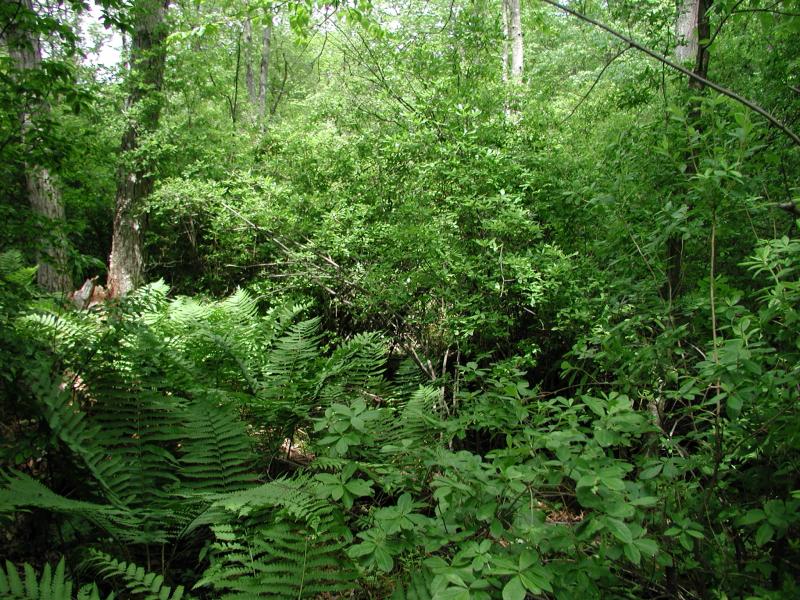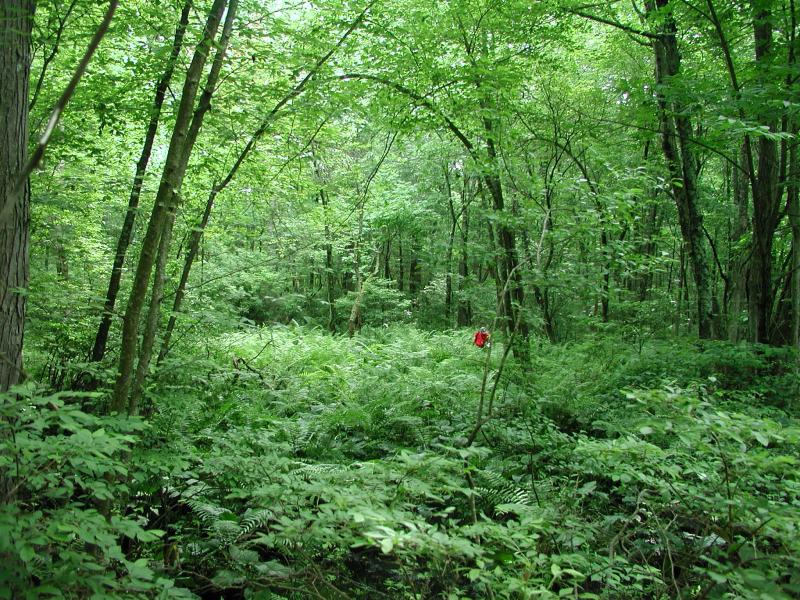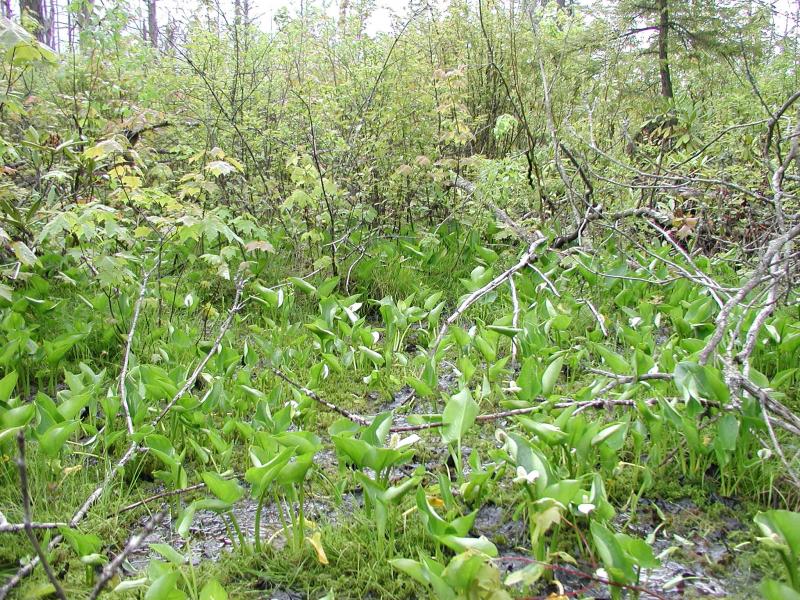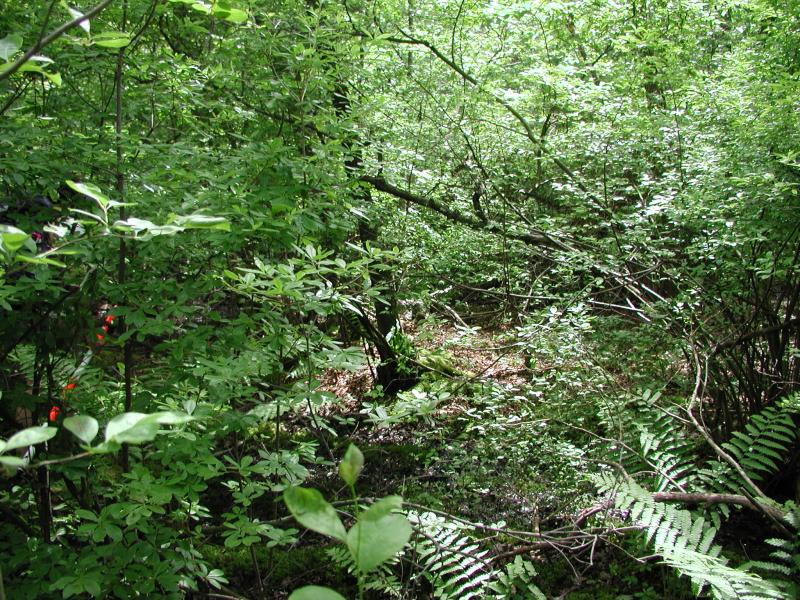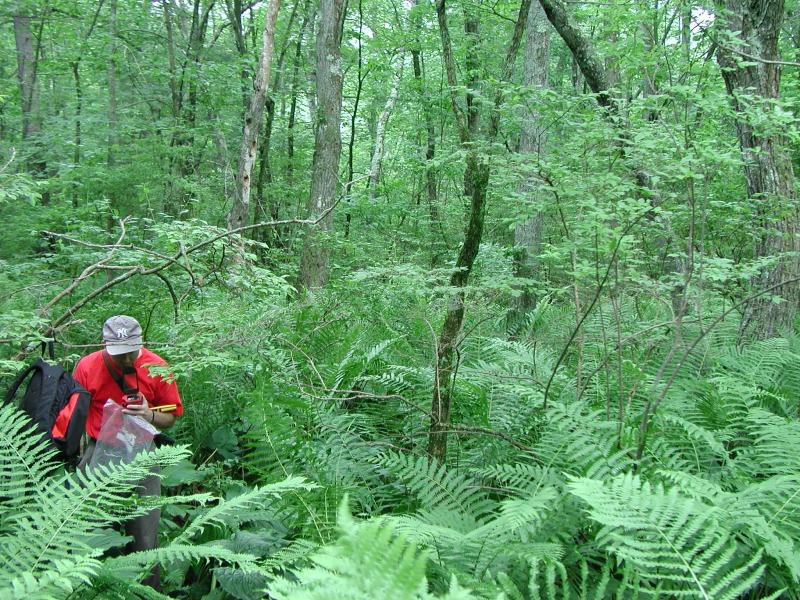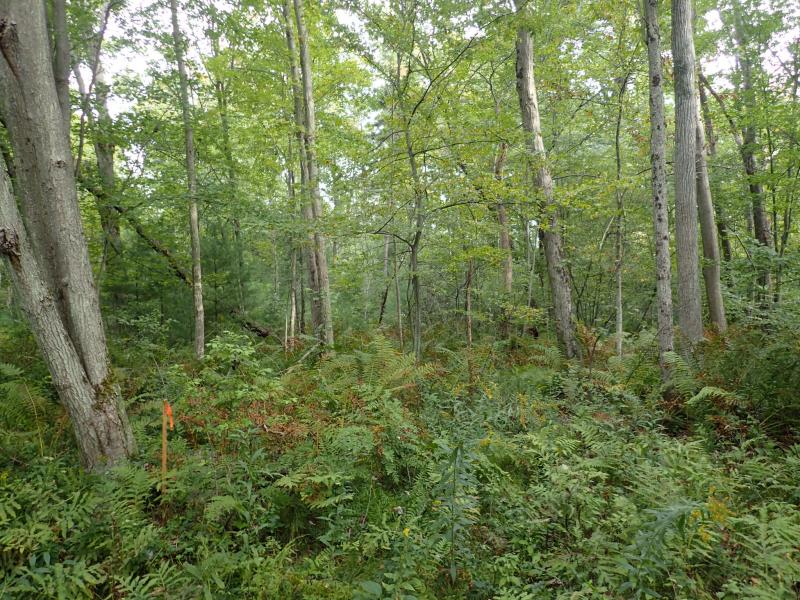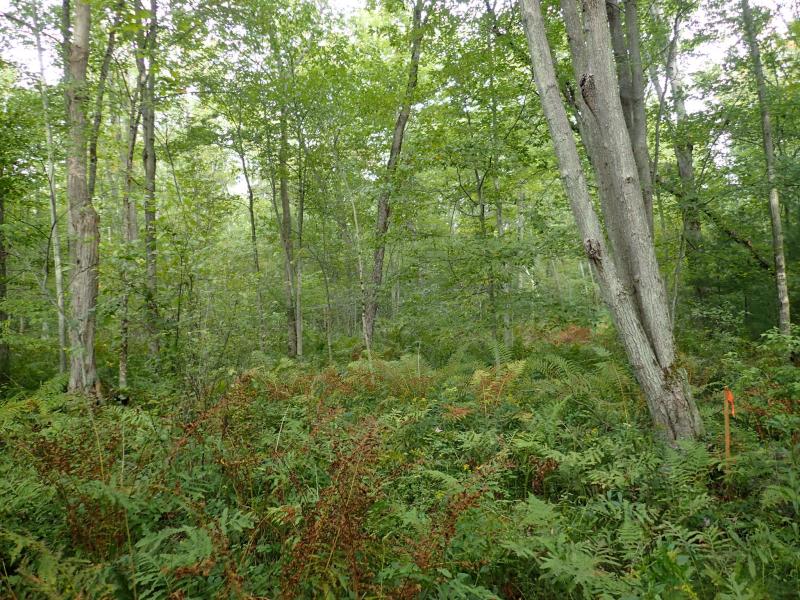Red Maple-Hardwood Swamp
- System
- Palustrine
- Subsystem
- Forested Mineral Soil Wetlands
- State Protection
- Not Listed
Not listed or protected by New York State.
- Federal Protection
- Not Listed
- State Conservation Status Rank
- S3S4
Vulnerable in New York, or Apparently Secure - Vulnerable to disappearing from New York (but not currently imperiled), with relatively few populations or locations, few individuals, and/or restricted range; or uncommon but not rare in New York; may be rare in some parts of the state; possibly some cause for long-term concern due to declines or other factors. More information is needed to assign either S3 or S4.
- Global Conservation Status Rank
- G5
Secure globally - Common in the world; widespread and abundant (but may be rare in some parts of its range).
Summary
Did you know?
Jewelweed, or touch-me-not, is an herb found in red maple-hardwood swamps. Its name comes from the jewel-like silvery coating on its leaves that is only evident when the leaves are submerged in water. The silvery covering is actually a thin layer of air trapped in microscopic leaf hairs. The plant was nicknamed touch-me-not because of its seed capsules, which split and coil when triggered by the wind or a touch, expelling the seeds and dispersing them up to four feet away.
State Ranking Justification
There are several thousand occurrences statewide. Some documented occurrences have good viability and several are protected on public land or private conservation land. This community has statewide distribution, and includes a few large, high quality examples. The current trend of this community is probably stable for occurrences on public land, or declining slightly elsewhere due to moderate threats that include alteration of the natural hydrology and invasive species.
Short-term Trends
The number and acreage of red maple-hardwood swamps in New York have probably declined slightly to moderately in recent decades in areas with ash decline, and stable elsewhere as a result of wetland protection regulations. Since World War II, urbanization has emerged as the predominant force impacting wetlands in most parts of the region (Golet et al. 1993).
Long-term Trends
The number and acreage of red maple-hardwood swamps in New York have probably declined substantially (about 80%) from historical numbers likely correlated with agricultural and other development. The principal causes of wetland loss in the Northeast prior to mid-1800s include conversion of wetlands to agriculture, the construction of impoundments for hydropower and water supply, and the cutting of swamp timber for lumber, fence posts, and fuel wood (Golet et al. 1993).
Conservation and Management
Threats
Red maple-hardwood swamps are threatened by development (e.g., agriculture, residential, commercial, roads), habitat alteration (e.g., excessive logging, pollution), and recreational overuse (e.g., hiking trails, ATVs). Alteration to the natural hydrological regime is also a threat to this community (e.g., impoundments, blocked culverts, beaver). Several red maple-hardwood swamps are threatened by invasive species, such as common buckthorn (Rhamnus cathartica), glossy buckthorn (Frangula alnus), shrubby honeysuckle (Lonicera morrowii), multiflora rose (Rosa multiflora), and barberry (Berberis thunbergii). Conversion of wetlands for agriculture was a major cause of inland wetland loss in many areas of the Northeast historically, and it is still an important factor today, most notably in New York (Golet et al. 1993). The emerald ash borer (Agrilus planipennis) is an Asian beetle that infests and kills North American ash trees. All native ash trees are susceptible, including white ash, green ash, and black ash. In New York, emerald ash borer has been found mostly south of the Adirondack Mountains, but in 2017 it was recorded in Franklin and St. Lawrence Counties. Natural communities dominated or co-dominated by ash trees would likely be most impacted by emerald ash borer invasion.
Conservation Strategies and Management Practices
Where practical, establish and maintain a natural wetland buffer to reduce storm-water, pollution, and nutrient run-off, while simultaneously capturing sediments before they reach the wetland. Buffer width should take into account the erodibility of the surrounding soils, slope steepness, and current land use. Wetlands protected under Article 24 are known as New York State "regulated" wetlands. The regulated area includes the wetlands themselves, as well as a protective buffer or "adjacent area" extending 100 feet landward of the wetland boundary (NYS DEC 1995). If possible, minimize the number and size of impervious surfaces in the surrounding landscape. Avoid habitat alteration within the wetland and surrounding landscape. For example, roads and trails should be routed around wetlands, and ideally not pass through the buffer area. If the wetland must be crossed, then bridges and boardwalks are preferred over filling. Restore past impacts, such as removing obsolete impoundments and ditches in order to restore the natural hydrology. Prevent the spread of invasive exotic species into the wetland through appropriate direct management, and by minimizing potential dispersal corridors, such as roads.
Development and Mitigation Considerations
When considering road construction and other development activities minimize actions that will change what water carries and how water travels to this community, both on the surface and underground. Water traveling over-the-ground as run-off usually carries an abundance of silt, clay, and other particulates during (and often after) a construction project. While still suspended in the water, these particulates make it difficult for aquatic animals to find food; after settling to the bottom of the wetland, these particulates bury small plants and animals and alter the natural functions of the community in many other ways. Thus, road construction and development activities near this community type should strive to minimize particulate-laden run-off into this community. Water traveling on the ground or seeping through the ground also carries dissolved minerals and chemicals. Road salt, for example, is becoming an increasing problem both to natural communities and as a contaminant in household wells. Fertilizers, detergents, and other chemicals that increase the nutrient levels in wetlands cause algae blooms and eventually an oxygen-depleted environment where few animals can live. Herbicides and pesticides often travel far from where they are applied and have lasting effects on the quality of the natural community. So, road construction and other development activities should strive to consider: 1. how water moves through the ground, 2. the types of dissolved substances these development activities may release, and 3. how to minimize the potential for these dissolved substances to reach this natural community.
Inventory Needs
Survey for occurrences statewide to advance documentation and classification of red maple-hardwood swamps. A statewide review of red maple-hardwood swamps is desirable. Continue searching for large sites in good condition (A- to AB-ranked).
Research Needs
Research composition of red maple-hardwood swamps statewide in order to characterize variations reported by Golet et al. (1993). Collect sufficient plot data to support the recognition of several distinct red maple-hardwood swamp types based on composition and by ecoregion.
Rare Species
- Ardea herodias (Great Blue Heron) (guide)
- Botrychium oneidense (Blunt-lobed Grape Fern) (guide)
- Callitriche terrestris (Terrestrial Water Starwort) (guide)
- Cardamine longii (Long's Bittercress) (guide)
- Carex haydenii (Cloud Sedge) (guide)
- Carex lupuliformis (False Hop Sedge) (guide)
- Carex mitchelliana (Mitchell's Sedge) (guide)
- Carex shortiana (Short's Sedge) (guide)
- Carex straminea (Straw Sedge) (guide)
- Carex styloflexa (Bent Sedge) (guide)
- Carex typhina (Cat-tail Sedge) (guide)
- Carex venusta (Dark-green Sedge) (guide)
- Diospyros virginiana (Persimmon) (guide)
- Equisetum palustre (Marsh Horsetail) (guide)
- Equisetum pratense (Meadow Horsetail) (guide)
- Euonymus americanus (American Strawberry Bush) (guide)
- Gentiana saponaria (Soapwort Gentian) (guide)
- Glyptemys muhlenbergii (Bog Turtle) (guide)
- Haliaeetus leucocephalus (Bald Eagle) (guide)
- Hypericum densiflorum (Bushy St. John's Wort) (guide)
- Juncus debilis (Weak Rush) (guide)
- Liparis liliifolia (Lily-leaved Twayblade) (guide)
- Lithobates kauffeldi (Atlantic Coast Leopard Frog) (guide)
- Magnolia virginiana (Sweetbay Magnolia) (guide)
- Melanerpes erythrocephalus (Red-headed Woodpecker) (guide)
- Nasiaeschna pentacantha (Cyrano Darner) (guide)
- Neottia auriculata (Auricled Twayblade) (guide)
- Neottia bifolia (Southern Twayblade) (guide)
- Pedicularis lanceolata (Marsh Lousewort) (guide)
- Persicaria setacea (Bristly Smartweed) (guide)
- Plantago cordata (Heart-leaved Plantain) (guide)
- Platanthera hookeri (Hooker's Orchid) (guide)
- Populus heterophylla (Swamp Cottonwood) (guide)
- Protonotaria citrea (Prothonotary Warbler) (guide)
- Quercus phellos (Willow Oak) (guide)
- Quercus shumardii var. shumardii (Shumard Oak) (guide)
- Setophaga cerulea (Cerulean Warbler) (guide)
- Sylvilagus transitionalis (New England Cottontail) (guide)
- Tipularia discolor (Cranefly Orchid) (guide)
- Vermivora chrysoptera (Golden-winged Warbler) (guide)
- Viola primulifolia (Primrose-leaf Violet) (guide)
Range
New York State Distribution
This community is known throughout the state except perhaps at the southern portion of Staten Island, where the community is replaced by the related red maple-sweetgum swamp. Apparently also absent from the higher elevations of the central Adirondacks and adjacent foothills (possible very small, scattered occurrences in the latter area). Different variants are concentrated in different ecoregions.
Global Distribution
The somewhat broadly-defined community may span much of the eastern United States and the southeastern fringe of Canada. Examples with the greatest biotic affinities to New York occurrences are suspected to be widespread throughout much of northeastern United States and the southeastern fringe of Canada. The range is estimated to span north to southern Ontario, west to Minnesota, southwest to Kentucky and Tennessee, southeast to North Carolina and Virginia, and northeast to Nova Scotia.
Best Places to See
- Perch River Wildlife Management Area (Jefferson County)
- Great Swamp Preserve (Putnam County)
- Connetquot River State Park Preserve (Suffolk County)
- Deer Mountain Nature Trail, Joralemon Town Park
- Wilson Hill Wildlife Management Area (St. Lawrence County)
- Franklin D. Roosevelt State Park (Westchester County)
Identification Comments
General Description
A hardwood swamp that occurs in poorly drained depressions, usually on inorganic soils with peat, if present, that is less than 20 cm deep. This is a broadly defined community with many variants. In any one stand red maple is either the only canopy dominant, or it is codominant with one or more hardwoods such as ash, elm, and birch. Blackgum (Nyssa sylvatica), sweetgum (Liquidambar styraciflua), and swamp white oak (Quercus bicolor) if present, are only minor associates. The shrub layer is usually well-developed and may be quite dense. The herbaceous layer may be diverse and is often dominated by ferns.
Characters Most Useful for Identification
A swamp dominated by red maple and hardwoods, such as ash, elm, and birch with little or no peat development. Blackgum, sweetgum, and swamp white oak if present, are only minor associates.
Elevation Range
Known examples of this community have been found at elevations between 10 feet and 1,710 feet.
Best Time to See
Because the characteristic plants of red maple-hardwood swamps are deciduous trees, it is easiest to identify the community during the growing season, from late May through summer. Striking seasonal leaf color can be enjoyed in the fall.
Red Maple-Hardwood Swamp Images
Classification
International Vegetation Classification Associations
This New York natural community encompasses all or part of the concept of the following International Vegetation Classification (IVC) natural community associations. These are often described at finer resolution than New York's natural communities. The IVC is developed and maintained by NatureServe.
- Red Maple / Upright Sedge - Sensitive Fern Wet Woodland (CEGL006119)
- Red Maple - (Green Ash, White Ash) / Northern Spicebush / Skunk-cabbage Swamp Forest (CEGL006406)
- Red Maple / Catberry - Highbush Blueberry Swamp Forest (CEGL006220)
- Red Maple / Swamp Azalea - Coastal Sweet-pepperbush Swamp Forest (CEGL006156)
- Black Ash - Red Maple / Alderleaf Buckthorn / Bristly-stalked Sedge Swamp Forest (CEGL007441)
NatureServe Ecological Systems
This New York natural community falls into the following ecological system(s). Ecological systems are often described at a coarser resolution than New York's natural communities and tend to represent clusters of associations found in similar environments. The ecological systems project is developed and maintained by NatureServe.
- North-Central Appalachian Acidic Swamp (CES202.604)
- North-Central Interior and Appalachian Rich Swamp (CES202.605)
- Northern Atlantic Coastal Plain Basin Swamp and Wet Hardwood Forest (CES203.520)
Characteristic Species
-
Trees > 5m
- Acer rubrum var. rubrum (common red maple)
- Betula alleghaniensis (yellow birch)
- Fraxinus pennsylvanica (green ash)
- Ulmus americana (American elm)
- Ulmus rubra (slippery elm)
-
Shrubs 2 - 5m
- Alnus incana ssp. rugosa (speckled alder)
- Ilex verticillata (common winterberry)
- Vaccinium corymbosum (highbush blueberry)
- Viburnum dentatum var. lucidum (smooth arrowwood)
- Viburnum nudum var. cassinoides (northern wild-raisin)
-
Shrubs < 2m
- Lindera benzoin (spicebush)
- Vaccinium corymbosum (highbush blueberry)
-
Herbs
- Boehmeria cylindrica (false nettle)
- Carex stricta (tussock sedge)
- Impatiens capensis (spotted jewelweed, spotted touch-me-not)
- Onoclea sensibilis (sensitive fern)
- Osmunda regalis var. spectabilis (royal fern)
- Osmundastrum cinnamomeum var. cinnamomeum (cinnamon fern)
- Symplocarpus foetidus (skunk-cabbage)
- Thalictrum pubescens (tall meadow-rue)
Similar Ecological Communities
- Floodplain forest
(guide)
Red maple-hardwood swamps are basin swamps. Basin indicator species should be greater than floodplain indicators (e.g., Calamagrostis canadensis, Persicaria virginiana, Boehmeria cylindrica and Urtica spp.). Other native species characteristic of floodplain forests that may be used to distinguish this community from red maple-hardwood swamp include Impatiens capensis, Solidago canadensis, Leersia virginica, and possibly Populus deltoides.
- Perched swamp white oak swamp
(guide)
Red maple-hardwood swamps form in depressions, but they are not necessarily perched. The canopy is dominated by red maple and may include ash, elm, birch, and swamp white oak. Swamp white oak, if present, does not dominate the canopy. In addition, red maple-hardwood swamps have a denser understory than perched swamp white oak swamps.
- Red maple-blackgum swamp
(guide)
While there may be some blackgum in red maple-hardwood swamps, it is not codominant as in red maple-blackgum swamps. Ash, elm, and birch are the characteristic codominants in red maple-hardwood swamps.
- Red maple-swamp white oak swamp
(guide)
Red maple-hardwood swamps may have some swamp white oak, but it is not codominant. Red maple-hardwood swamps are usually permanently saturated compared to red maple-swamp white oak swamps that draw down in most years.
- Red maple-sweetgum swamp
(guide)
Red maple-sweetgum swamps have red maple and sweetgum as canopy codominants, with other canopy species present in low densities. Also red maple-sweetgum swamps often occur on somewhat poorly-drained flats, rather than in basins.
- Red maple-tamarack peat swamp
(guide)
Red maple-dominated swamps with deep peats (>20 cm) over calcium-rich soils may grade into forested peatlands such as red maple-tamarack peat swamp, which is co-dominated by tamarack.
- Silver maple-ash swamp
(guide)
The gradient between red maple-hardwood swamp and silver maple-ash swamp is difficult to identify. In red maple-hardwood swamps, Acer saccharinum typically occurs at less than 25% cover and is usually less abundant than Acer rubrum; otherwise the community may grade into silver maple-ash swamp. A hybrid between red maple and silver maple, Acer x freemanii, is more typical in silver maple-ash swamps. Combined cover of typical indicators of silver maple-ash swamp such as Acer saccharinum, Ribes spp., and Laportea canadensis are typically less than that of indicators of red maple-hardwood swamp such as Acer rubrum, Viburnum denatum, Viburnum nudum, and Vaccinium corymbosum. Additionally, presence of underlying acidic bedrock, low pH, and scarcity of other calciphilic species such as Rhamnus alnifolia and Thuja occidentalis are more indicative of red maple-hardwood swamp than of silver maple-ash swamp.
Vegetation
Percent cover
This figure helps visualize the structure and "look" or "feel" of a typical Red Maple-Hardwood Swamp. Each bar represents the amount of "coverage" for all the species growing at that height. Because layers overlap (shrubs may grow under trees, for example), the shaded regions can add up to more than 100%.
Additional Resources
References
Cain, S.A. and W.T. Penfound. 1938. Aceretum rubri: The red maple swamp forest of Central Long Island. Amer. Midland Naturalist 19:390-416.
Cowardin, L.M., V. Carter, F.C. Golet, and E.T. La Roe. 1979. Classification of wetlands and deepwater habitats of the United States. U.S. Fish and Wildlife Service. Washington, D.C. 131 pp.
Edinger, G. J., D. J. Evans, S. Gebauer, T. G. Howard, D. M. Hunt, and A. M. Olivero (editors). 2014. Ecological Communities of New York State. Second Edition. A revised and expanded edition of Carol Reschke’s Ecological Communities of New York State. New York Natural Heritage Program, New York State Department of Environmental Conservation, Albany, NY. https://www.nynhp.org/ecological-communities/
Edinger, Gregory J., D.J. Evans, Shane Gebauer, Timothy G. Howard, David M. Hunt, and Adele M. Olivero (editors). 2002. Ecological Communities of New York State. Second Edition. A revised and expanded edition of Carol Reschke's Ecological Communities of New York State. (Draft for review). New York Natural Heritage Program, New York State Department of Environmental Conservation. Albany, NY. 136 pp.
Golet, F.C., A.J.K. Calhoun, W.R. DeRagon. D.J. Lowry, and A.J. Gold. 1993. Ecology of red maple swamps in the glaciated Northeast: A community profile. U.S. Fish and Wildlife Service Biological Services Program FWS/OBS-84/09.
McVaugh, R. 1958. Flora of the Columbia County area, New York. Bull. 360. New York State Museum and Science Service. University of the State of New York. Albany, NY. 400 pp.
New York Natural Heritage Program. 2024. New York Natural Heritage Program Databases. Albany, NY.
New York Natural Heritage Program. No date. Field forms database: Electronic field data storage and access for New York Heritage ecology, botany, and zoology. New York Natural Heritage Program, New York State Department of Environmental Conservation. Albany, NY.
New York State Department of Environmental Conservation. 1995. Freshwater Wetlands: Delineation Manual. July 1995. New York State Department of Environmental Conservation. Division of Fish, Wildlife, and Marine Resources. Bureau of Habitat. Albany, NY.
Reschke, Carol. 1990. Ecological communities of New York State. New York Natural Heritage Program, New York State Department of Environmental Conservation. Latham, NY. 96 pp. plus xi.
Links
About This Guide
This guide was authored by: Aissa Feldmann
Information for this guide was last updated on: May 16, 2024
Please cite this page as:
New York Natural Heritage Program. 2024.
Online Conservation Guide for
Red maple-hardwood swamp.
Available from: https://guides.nynhp.org/red-maple-hardwood-swamp/.
Accessed July 27, 2024.

